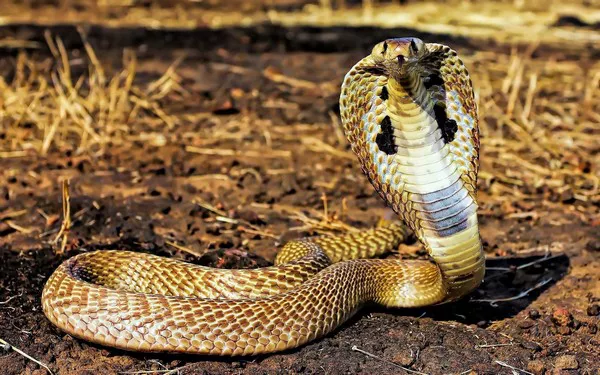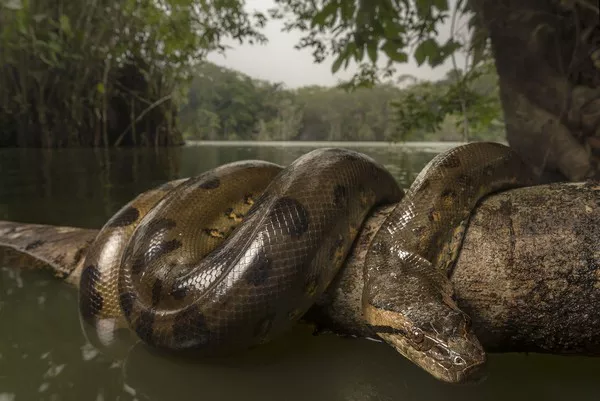Venomous snakes have always intrigued and terrified humans. Among these fascinating reptiles, some are particularly notable for their impressive length. This article explores the 10 longest venomous snakes in the world, delving into their habitats, behaviors, and the potency of their venom. From the infamous king cobra to the lesser-known but equally formidable species, we uncover the unique characteristics that make these serpents the giants of the venomous snake world.
10 Longest Venomous Snakes
1. King Cobra (Ophiophagus hannah)
Length and Description
The king cobra holds the title for the longest venomous snake in the world, with lengths often exceeding 18 feet (5.5 meters). Some individuals have been recorded at nearly 20 feet (6 meters). This snake is easily recognizable by its olive or brown coloration and distinctive hood.
Habitat and Distribution
King cobras are found in forests, bamboo thickets, mangrove swamps, and agricultural areas across Southeast Asia, India, and southern China. They prefer habitats near water bodies such as streams and rivers.
Venom and Behavior
Despite their fearsome reputation, king cobras are generally shy and avoid human contact. However, when threatened, they can raise up to a third of their body off the ground and spread their hood in a dramatic display. Their venom, which primarily affects the nervous system, can be fatal to humans if not treated promptly.
See Also: The Top 10 Heaviest Snakes – You May Not Know
2. Black Mamba (Dendroaspis polylepis)
Length and Description
The black mamba is the second longest venomous snake, reaching lengths of up to 14 feet (4.3 meters). It is known for its sleek, olive to grayish-brown body and coffin-shaped head. Despite its name, the inside of its mouth is black, which it displays when threatened.
Habitat and Distribution
Native to sub-Saharan Africa, black mambas inhabit savannas, rocky hills, and open woodlands. They are highly adaptable and can sometimes be found in agricultural areas.
Venom and Behavior
Black mambas are notorious for their speed, agility, and potent venom. They can move at speeds of up to 12 mph (20 km/h). Their venom is a complex mixture of neurotoxins and cardiotoxins, causing rapid onset of symptoms and potentially fatal respiratory failure. Despite their aggressive reputation, black mambas typically avoid confrontation and will only strike if cornered.
3. Coastal Taipan (Oxyuranus scutellatus)
Length and Description
The coastal taipan, also known as the common taipan, can grow up to 9.5 feet (2.9 meters) in length. It has a slender body, light olive to dark brown coloration, and a pale head.
Habitat and Distribution
This snake is found in coastal regions of northern and eastern Australia and the island of New Guinea. It prefers habitats such as sugarcane fields, forests, and grassy areas.
Venom and Behavior
The coastal taipan’s venom is extremely toxic, with a lethal dose capable of killing an adult human in under an hour. It contains potent neurotoxins and procoagulants. These snakes are highly alert and can deliver multiple bites in quick succession when threatened.
4. Forest Cobra (Naja melanoleuca)
Length and Description
The forest cobra is the longest true cobra, reaching lengths of up to 10 feet (3 meters). It has a glossy black body with occasional white or yellow bands and a wide hood.
Habitat and Distribution
Forest cobras are found in Central and West Africa, inhabiting forests, savannas, and agricultural areas. They are versatile and can live in a variety of environments, including near human settlements.
Venom and Behavior
Forest cobras are highly venomous and can deliver a significant amount of venom in a single bite. Their venom contains neurotoxins and cytotoxins, causing severe pain, tissue damage, and paralysis. They are generally aggressive when cornered but will often try to escape when encountered.
5. Indian Cobra (Naja naja)
Length and Description
The Indian cobra, also known as the spectacled cobra, can grow up to 7.5 feet (2.3 meters). It is known for the distinctive hood markings resembling spectacles. Its coloration varies widely, from light brown to black.
Habitat and Distribution
Indian cobras are widely distributed across the Indian subcontinent, including India, Pakistan, Sri Lanka, and Bangladesh. They inhabit forests, fields, and urban areas, often near human dwellings.
Venom and Behavior
The Indian cobra’s venom is a potent mix of neurotoxins and cardiotoxins, capable of causing respiratory failure and cardiac arrest. Despite their lethal potential, these cobras are often depicted in traditional snake charming performances, where they are typically de-fanged.
6. King Brown Snake (Pseudechis australis)
Length and Description
Also known as the mulga snake, the king brown snake can reach lengths of up to 11 feet (3.3 meters). It has a robust build, with coloration ranging from light brown to dark olive.
Habitat and Distribution
King brown snakes are found throughout most of Australia, except for the southeastern and southwestern coastal areas. They thrive in a variety of habitats, including deserts, grasslands, and woodlands.
Venom and Behavior
Despite its name, the king brown snake is not a true brown snake but belongs to the black snake family. Its venom contains myotoxins, neurotoxins, and anticoagulants, leading to muscle damage, paralysis, and uncontrolled bleeding. These snakes are typically shy but can become aggressive when threatened.
7. Eastern Diamondback Rattlesnake (Crotalus adamanteus)
Length and Description
The eastern diamondback rattlesnake is the longest rattlesnake species, with individuals growing up to 8 feet (2.4 meters). It is characterized by its distinctive diamond-shaped pattern along its back and a heavy, muscular body.
Habitat and Distribution
This rattlesnake is native to the southeastern United States, from North Carolina to Louisiana and Florida. It prefers dry, sandy areas such as pine forests, coastal scrublands, and grasslands.
Venom and Behavior
The eastern diamondback’s venom is a complex cocktail of enzymes, hemotoxins, and neurotoxins. It can cause severe pain, tissue damage, and systemic effects. Known for its rattle, which it uses as a warning signal, this snake is generally non-aggressive and will try to avoid confrontation.
8. Gaboon Viper (Bitis gabonica)
Length and Description
The Gaboon viper is one of the longest and heaviest vipers, growing up to 7 feet (2.1 meters) in length. It has a distinctive triangular head, large fangs, and a beautiful pattern of browns, purples, and pinks.
Habitat and Distribution
Gaboon vipers are found in the rainforests and savannas of West and Central Africa. They prefer dense, humid environments with plenty of cover from vegetation.
Venom and Behavior
Gaboon vipers possess the longest fangs of any snake, reaching up to 2 inches (5 cm). Their venom contains hemotoxins and neurotoxins, causing rapid swelling, pain, and tissue damage. These snakes are known for their docile nature and are reluctant to bite unless provoked.
9. Bushmaster (Lachesis muta)
Length and Description
The bushmaster is the longest pit viper, capable of reaching lengths of up to 12 feet (3.7 meters). It has a reddish-brown to yellowish coloration with a series of black, diamond-shaped patterns along its back.
Habitat and Distribution
Bushmasters are found in the tropical rainforests of Central and South America, from Costa Rica to Brazil. They prefer humid, forested areas with ample leaf litter and undergrowth.
Venom and Behavior
Bushmasters have a potent venom that contains hemotoxins and neurotoxins, causing severe pain, swelling, and systemic effects. They are known for their secretive and nocturnal nature, often avoiding human contact. However, when threatened, they can deliver multiple bites in rapid succession.
10. Eastern Coral Snake (Micrurus fulvius)
Length and Description
The eastern coral snake can grow up to 4 feet (1.2 meters) in length, making it the longest species of coral snake. It is easily recognized by its brightly colored bands of red, yellow, and black.
Habitat and Distribution
Eastern coral snakes are found in the southeastern United States, from North Carolina to Florida and west to Louisiana. They inhabit forests, swamps, and sandy areas, often hiding under leaf litter and debris.
Venom and Behavior
The venom of the eastern coral snake is primarily neurotoxic, affecting the nervous system and causing paralysis. Despite its potent venom, this snake is reclusive and rarely encountered by humans. Coral snakes typically deliver a less aggressive bite compared to other venomous snakes, but their venom can still be deadly if not treated promptly.
See Also: Top 20 Deadliest Snakes in the World
Conclusion
The world of venomous snakes is both fascinating and diverse, with each species exhibiting unique adaptations that enable them to thrive in their respective habitats. The 10 longest venomous snakes are remarkable not only for their impressive lengths but also for their potent venoms, striking appearances, and varied behaviors. Understanding these giants of the serpent world can help us appreciate the complexity and beauty of these often-misunderstood creatures. As research and conservation efforts continue, we gain more insights into their ecology and the vital roles they play in maintaining the balance of ecosystems around the globe.
You Might Be Interested In:


























